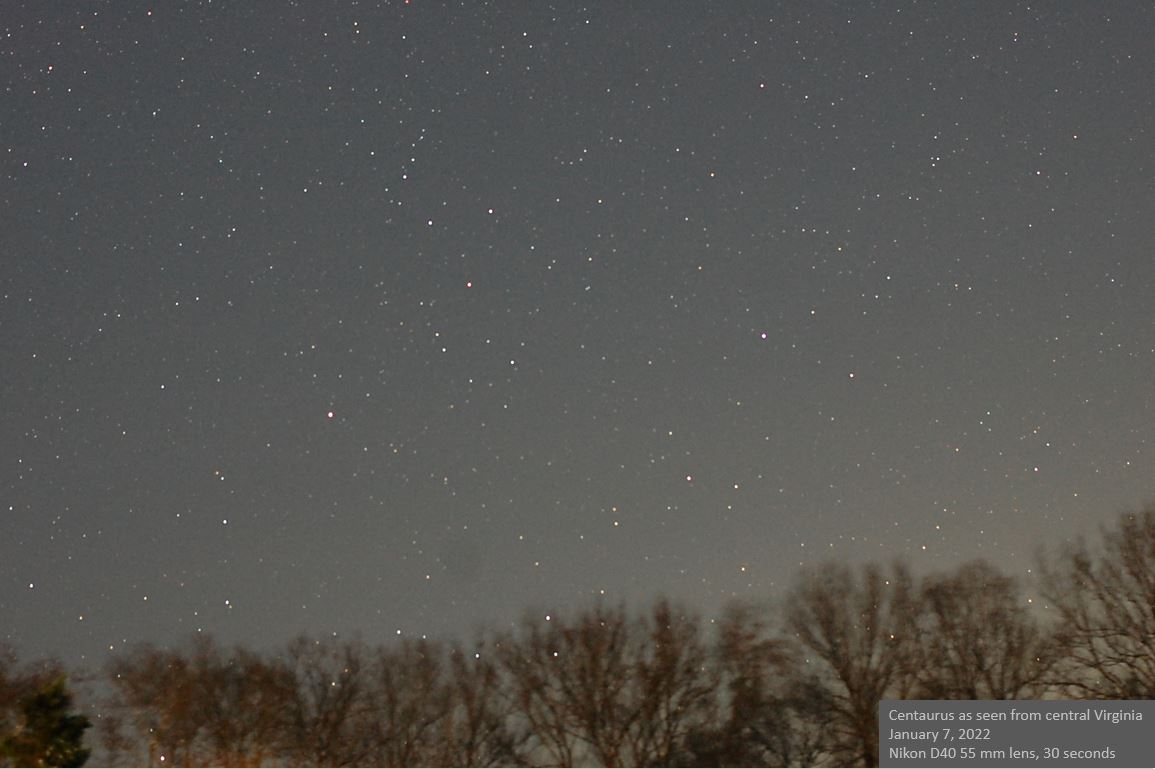
|
January 26
Jupiter continues to move rapidly through Aquarius, as we can see in
this image on which I have marked its progress eastward in the last
twelve days. The star just below and slightly left of Jupiter
is σ Aquarii. Jupiter's next destination is λ which
it will pass around February 19, although that will likely be too near
the Sun to observe.
|

|
January 24
Venus is rapidly climbing higher in the morning sky after its inferior
conjunction on January 8, and owing to its great elevation north of the
ecliptic, will soon be higher than Mars. On this morning, Venus
was almost 6° 45' above the ecliptic, which is greater than its
elevation when it passed north of the Sun. Mars will slide under
Venus and just barely get ahead of it in their race eastward, but Venus
will soon catch back up and pass Mars on its way to Saturn and then the
close conjunction with Jupiter in April.
|

|

|
January 14
Our weather in central Virginia was clear and cold this Friday the 14th, so we
had a nice view of Saturn and Mercury, dimming and low in the evening twilight,
as well as Jupiter much higher to their upper left. Jupiter will spend
the first four months of the year moving through Aquarius but come to opposition
in late September in southern Pisces, in a very similar manner to its 2010
apparition.
|

|

|
January 8
Venus is passing through inferior conjunction sometime today or possibly early
on January 9, so around 1:30 EST in central Virginia I was able to view Venus
very nicely while blocking the Sun with the roof of my house. I used a
1974 vintage C8 and a 12mm eyepiece for about 166x and took the picture afocally
with my iPhone 6.
|

|

|
January 7
The evening of January 7 presented skywatchers with an almost perfectly
straight line of planets comprising Jupiter - Saturn - Mercury from upper
left to lower right, and as one might expect with that close of an alignment,
they are all nearly equidistant from the ecliptic, all south of it. In
particular in the second image, the more greyish one, the stars of Capricornus
can be seen.
|

|
January 7
No planets in this view, but instead a visit to the southern constellation
Centaurus. Tony Flanders wrote an interesting article in the April 2019
issue of Sky & Telescope magazine on Centaurus and Crux, focusing on how much
of Centaurus one can see from mid-northern latitudes. So here I wanted
to illustrate how much I can see over my low, distant treeline from the
latitude of Fredericksburg, Virginia. In this view, the two northern
stars of θ and ι have not culminated yet, so potentially a little
more of the constellation would be visible an hour beyond this time, but for
this time of year, it would be mid-twilight!
|

|
January 7
While rummaging around in my astronomy cabinets, I discovered my 72mm
solar filter for camera lenses, so I decided to try it out on my Nikkor
300mm lens today, since I knew there was a very nice group of sunspots
near the center of the Sun. The results were "meh" in my opinion;
at 1/800th of second, the color rendition of the Sun was pretty good,
but 300mm focal length is just not enough to get a sharp view of the
sunspot group with my setup. Better imagers probably could LOL!
|

|

|

|

|
January 4
Mars is the only morning planet, rising next to Scorpius almost exactly two hours
before sunrise, while the other four naked-eye planets are strung out in the evening
sky, Jupiter - Saturn - Mercury - Venus from top to bottom.
|

|

|

|

|
January 3
Nice sunny late afternoon following a 12" snowfall earlier in the day, orange
razor-thin crescent Moon, and planet pairings! The only thing I didn't get
an image of was Venus' crescent earlier in the evening.
|